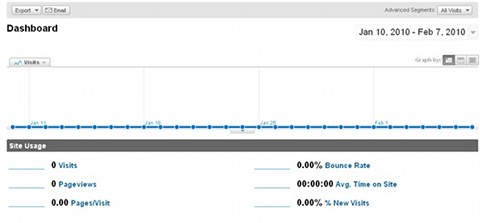
Sometimes, a Google Analytics installation doesn’t behave quite how you might expect it to, showing inconsistent data or just behaving strangely.
It isn’t always easy to see what might be causing the problem, but at Coast Digital we often come across accounts that have been set up incorrectly, or have crucial tracking code mistakes.
That’s why we’ve decided to share of the more common problems that we encounter, what the symptoms are and how best to fix them.
Problem 1: There’s no data in my Analytics account
More often than not, this is caused by missing, wrong, or incorrect tracking code.
The Google Analytics tracking code is account and profile specific, so make sure that the right code for the right account is installed on the right site.
To minimise potential problems, update the older urchin.js tracking code to the new ga.js code – or, if you’re feeling adventurous, use the upcoming asynchronous tracking code instead.

Problem 2: An overall drop of traffic from all sources
If this happens, the tracking code is probably missing from some pages on your site.
Check the traffic levels to specific pages to determine which ones are causing the trouble, and then repair them.
It’s easier to spot offending pages if they are among the most visited, but can be trickier if the tracking code is missing from a variety of less popular pages. It’s also worth checking to see whether your tracking code is missing or incorrectly set on any subdomain – we’ll cover this scenario a bit later on.
Problems with the tracking code can occur very easily if your site has a number of users who have access to your content management system (CMS) – particularly if they are able to a site where a number of users have access to the Content Management System, can revert to old versions of page content easily, or have access to the template code.
Top Tip: there is a very handy Firefox plugin called “GA?” that will show you at a glance whether a page has Analytics tracking code installed on it. Download it from the Firefox add-on site at https://addons.mozilla.org/en-US/firefox/addon/5631
Problem 3: No AdWords cost data is showing
This often occurs when your AdWords account is not linked to your Analytics account.
There is a manual setting that must be applied before cost data is shown.
To check that it is active, log into your AdWords account, click on the ‘My Account’ tab, and then on ‘Account Preferences’. Beneath ‘Tracking’, you will see the ‘Auto Tagging’ setting’ – this should be set to ‘Yes’.
![]()
You should also check that your AdWords account is linked to the correct Analytics account – if it isn’t, no data will be collected.
Problem 4: No Keyword or Ad Group data for non-Google PPC traffic
Although AdWords can – with a single setting – share cost and campaign information with Analytics, it’s not as simple if you want to do the same with MSN/Bing, Yahoo! or another provider.
If you do want to do this, you need to make sure that each destination URL is tagged correctly, allowing it to pass keyword and campaign information to Analytics. For details on how to do this, see the earlier post in this series, ‘Tracking External Sources & Tagging URLs’.
It is worth noting that cost data from other providers cannot be passed into Analytics.
Problem 5: A drop in traffic from one PPC source
You can usually pinpoint this problem to a tagging issue. Destination URLs may have been changed without the the correct UTM parameters being appended, or there may be a problem with the PPC account – ads may have stopped running for billing reasons, for example.
Problems can easily occur where there is a number of people responsible for maintaining PPC accounts – they may make changes to advert destination URLs and keyword destination URLs, so it is important that you share your tracking techniques with the everyone concerned.
Problem 6: An entry labeled ‘(Other)’ appears in your content report
If your Analytics account is tracking more than 50,000 unique URL or page views, then all pages that don’t appear in the most popular 50,000 are bracketed together in a section called ‘other’.
One way to prevent this happening is to exclude certain dynamic parameters within your Analytics settings, group like pages together, or run filter sets to that different profiles within the account to report on different segments of data.
Problem 7: Spikes in direct traffic that coincide with bulk email sends
If this happens, it’s probably because email traffic is being reported in Analytics as ‘direct’ traffic – it’s a result of untagged links in emails.
Normally, visits from email clients like Outlook – which open a web browser when you click on a link – are registered as direct traffic. In addition, some webmail traffic – notably Hotmail and Gmail – will also be recorded as ‘referral’.
Once again, the solution is to add tags to email URLs – refer to ‘Tracking External Sources & Tagging URLs’ for details on how to do this.
Problem 8: Goals aren’t appearing
If no goals are showing up in the relevant Analytics report, make sure that your goal URLs are correct. All too frequently, we see the full URL path entered, including the http:// – you need to omit the domain name.
For example, if your goal is at the URL http://www.mysite.com/thankyou.html, you should use ‘/thankyou.html’ as your Goal URL.

You should also check that your ‘thank you’ page resolves to the correct address – if someone changes the location of the ‘thank you’ page, even though conversions may be coming through to your CMS, database or email inbox, they won’t appear in Analytics.

Problem 9: A significant number of referrals from your own site
A certain number of legitimate self-referrals should be accepted as ‘normal’ in an Analytics account – particularly from visitors that let 30 minutes pass before clicking on another link on site.
However, if self-referrals form a significant segment of your traffic, a number of things could be to blame:
- Missing or broken tracking code on some pages. If a popular page is missing tracking code, visitors that hit that page can subsequently be tracked as referral visitors from your own domain name. Identify these pages by looking at the content report to identify missing pages and make sure the correct tracking code is installed on them.
- Multiple domains and cross domain tracking not set up correctly. If your site spans across an external domain – such as a checkout on a third party provider’s site – tracking must be set up to pass data between the two. They both need to have the same Analytics tracking codes on, with _setAllowHash(false) and _setAllowLink(true) lines added to the code. The referral page should also have each link tagged with _link(). See Advanced Setup Process and Filters for more details.
- Multiple subdomains. If the secure area of your site sits at a subdomain, such as secure.mysite.com, the Analytics tracking code should be updated to include the line _setDomainName(‘.mysite.com’), to ensure that cross sub-domain tracking is enabled. Once again, see Advanced Setup Process and Filters for help.

.jpg)